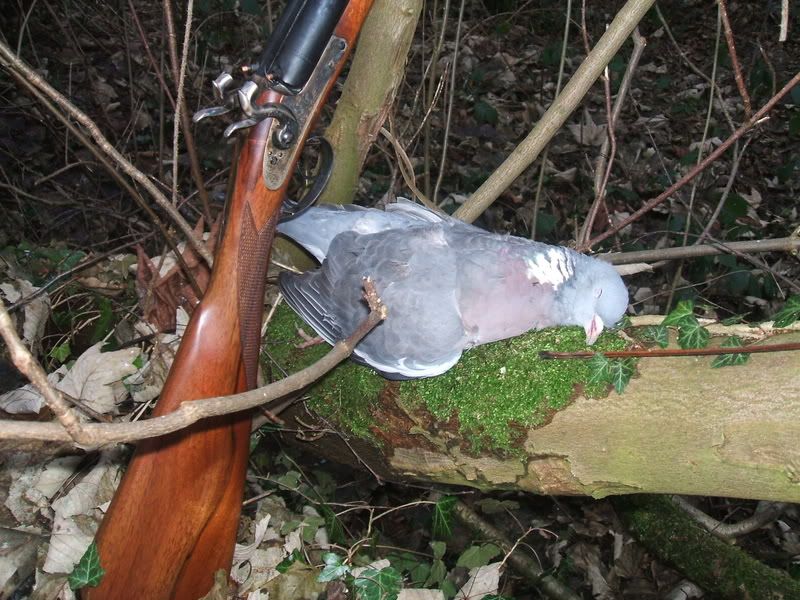unfortunately, I don't save those tomes( or fortunately??) :grin:
But, here it is in a nutshell.
First, I am all in favor of bending barrels to correct larger errors in POINT OF IMPACT(POI).
Filing the muzzle is to make the changes:
a. If you can't bend the barrel for some reason( as in DBL shotguns- where you are concerned with breaking the solder between the barrels, or where one barrel is more off- or off in a different direction than the other); and
b. For small deviations for the POI from the POA.
For my purpose, I am treating this subject as if we are using a DB shotgun, so that the bead is held at the 12 o'clock( clock dial) position to the target.
Now, lets assume the LEFT barrel( Your left as you look down the barrels from the butt stock) is shooting LEFT- to 9 o'clock, and the center of the pattern is 12+ inches off from the POA.
You want to move that shot so that it more closely impacts the center of the pattern at the POA.
WHAT TO DO:
FILE THE LEFT BARREL MUZZLE AT 9 o'CLOCK. It sounds counter intuitive, until you think about what is going to push that shot one way or another. Its the Gases pushing the shot, and wads or cards behind the gas out of the muzzle that will move the shot in one direction or another. By filing the muzzle at 9 O'clock, GAS will Escape out the muzzle at 9 o'clock FIRST, and push the wad and shot towards 3 o'clock, moving it in that direction to get closer to the POA. The more you file the muzzle, the more the load of shot will move in the OPPOSITE direction.
Some DBL shotguns are constructed so that their patterns actually cross( we see this also in Dbl. rifles).
IN those cases, sometimes it simply makes more sense to break or cut the solder between the barrels and use wedges near the muzzle to push the barrels away from each other. When you have the barrels shooting patterns to a similar POA, THEN re-solder the barrels and ribs.
However, I have seen many OLD barrels on DBL shotguns that have been filed in the middle of the two barrels, so that the shot patterns move away from crossing over each other, and shoot to a similar POA. The muzzles of those barrels have a half-moon, or "half-round" profile , under that front sight. Some old guns that were big, 10 gauge duck and geese guns- way too heavy to use on upland game--- had extremely pronounced filing marks on that work- leaving no doubt how the arc was made.
Lets assume your left barrel is shooting to 9 O'clock, as above, but the Right barrel is shooting Low Right- at 4:30 O'clock. You would file the left barrel's muzzle to move the pattern to the right, as described above. Then, on the right barrel, you would file the muzzle at 4:30 O'clock to move the pattern UP and LEFT to your POA.
Any smoothbore has a much better chance of shooting its load of shot to the POA if that muzzle is Squared to the bore. Most owners of shotguns never even check. For that matter, most never patterned their loads on paper.
I am not expecting people to count pellets- altho that's the only way to really know what is happening with your gun. Why Not? Well, after you have patterned loads and counted pellets, until you think you are going cross-eyed, you begin to know what a good pattern looks like, and even can tell fairly accurately if a pattern is Cylinder bore, Modified, or full for a particular load at a given range. The Bad patterns stick out so easily, that there is No reason to count pellets.
By process of eliminating the obviously bad patterns, you can reach the correct load that gives you a great pattern. That is the one to take the time to count pellets. Then try patterning that same load at different distances from the muzzle so you learn how it performs at those distances.
What is a great pattern? You want your shot pellets to be fairly evenly distributed through out a 20-30 inch circle in the center of the pattern. Hopefully, you won't have "tails" flying off one side of the pattern or another.
If there is going to be an area of denser pellets, let it be in the 10-15 inch inner circle of the pattern. When you hit flying birds with such a pattern, you are rewarded with lots of feathers leaving the bird, and an immediate reaction to the load of shot, when you center the bird. If you hit that bird with one edge of the pattern or another, you will be able to see the bird react in the opposite direction.
The same kind of reaction occurs when shooting Clay targets, and that is the reason we spend so much time practicing with our guns shooting clay targets throw from a mechanical trap, or hand thrower. :hmm: :surrender: :thumbsup: :thumbsup:






